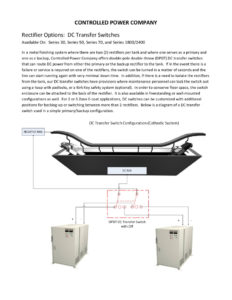Series 2400 Modular Rectifier
Description:
The Series 2400 is a modular, water-cooled, primary SCR, DC power supply. The Series 2400’s modular configuration provides expandability for increasing future capacity of the unit, as well as redundancy for “fail safe” reliability and reduced downtime.
Input AC Voltage: 208V – 600V
Output DC Voltage Range: 6V – 600V
Output DC Current Range: 37A – 36,000A

- Significantly reduced downtime
- Modular expandability
- “Fail safe” reliability
- Water-cooled
- Simplified maintenance
- Completely automatic
- Small footprint
- Input Line Variation: ± 5% from nominal
- Voltage Regulation: ± 0.5%
- Current Regulation: ± 0.5%
- Operating Range: 0°C – 40°C
- Efficiency: 85% – 93%
- Electro-coating
- Anodizing
- Electro-machining
- Electro-refining
- Plating
Learn more about this product! Read our brochures and other supporting documents!
- What are the advantages of a modular rectifier design?
- How can I reduce or eliminate down time?
- What size rectifier do I need?
- Which is better: air- or water-cooling?
- Which leg of the rectifier is grounded?
- Can I control or monitor the rectifier with my PLC?
- How can I reduce the floor space needed for rectifiers used in my process?
- Do I need a separate feeder transformer for the rectifier?
- When do I need a DC switch?
- How can I increase my rectifier current output?
AACD
The Automatic Average Current Density (AACD) is an available voltage control option with this E-Coat rectifier. Based upon the size of the part being painted, the AACD automatically adjusts the DC voltage (throw power) in order to control the amount of paint applied to the part. The result is that over-coating and under-coating are reduced or eliminated; thus saving money related to excess paint usage and rework costs. For additional product and application details, please visit our AACD webpage!
Warranty
Controlled Power Company warrants the Series 2400 Modular Rectifier to be free from defects in material and workmanship for a period of one (1) year following shipment from the factory. Controlled Power Company agrees to replace, F.O.B. its factory, any parts which fault through defect in material or workmanship during the warranty period.
Consult the factory for additional warranty details, and a description of start-up services provided.













